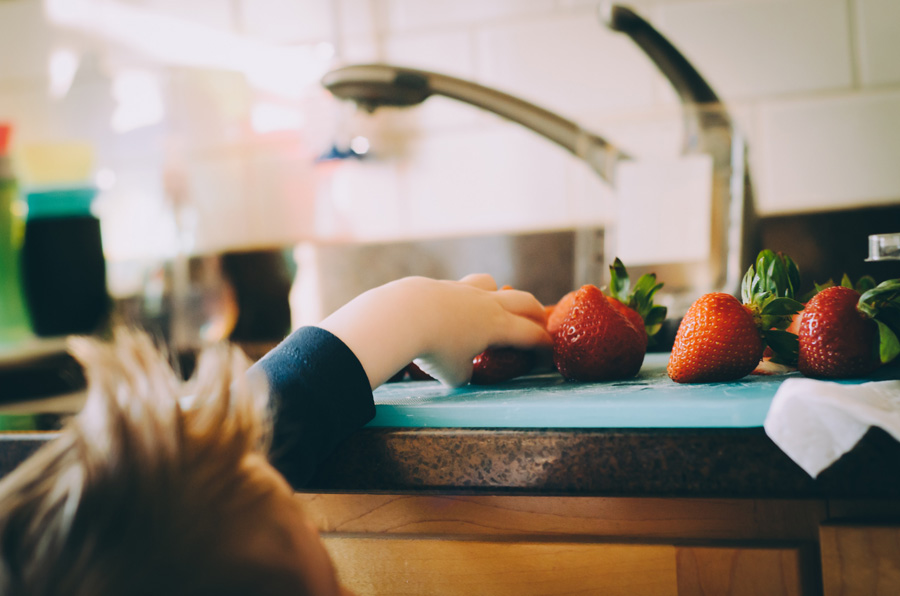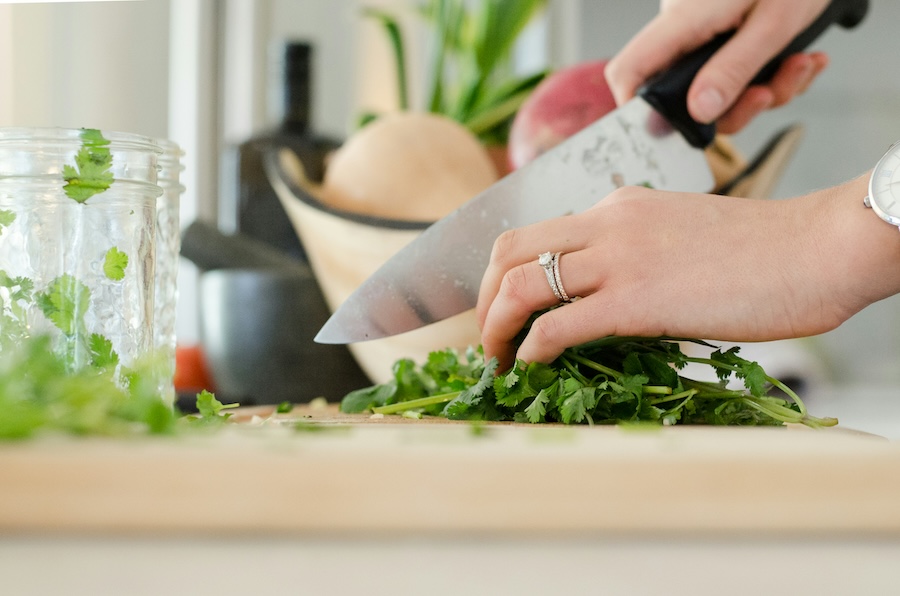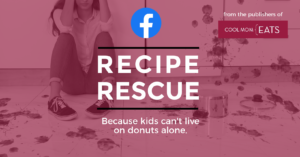No matter our personal eating or cooking habits, all parents have one food concern in common: We want our kids to eat healthy. Naturally, most of us work on this at mealtimes; we look for healthy kid-friendly recipes, we trade tips on how to encourage kids to eat more vegetables, and sometimes we even get sneaky and hide veggies in their meals.
But it turns out that we can be even more effective if we encourage healthy eating habits outside of the pressures of meal times and away from the dinner table. We can make a difference in a much more fun (and easy) way than yelling, “Eat your vegetables!” on repeat.
This is why I couldn’t be more excited to be working with the Whole Kids Foundation to share the Starting with Soil app, a free tablet-based app that turns learning about the science of growing food into a fun and engaging game.
Fun + educational? That’s speaking our language.
But of course, technology isn’t the only answer. So we’ve got quite a few clever ways to help you get kids excited about healthy eating away from the table.
1. Keep books about food around the house.

Ah, books: the original technology. And, if you ask me, still one of the most effective ways to get kids excited about any topic, even if you don’t have an avid reader. So be sure to have plenty of books around and in reach, on topics like healthy foods, growing food and food sources, and eating well.
For very young kids: A good place to start is this list of children’s books about food that are great for kids up to about 8 years old. If you’ve got pre-readers, it’s easy to find board books featuring colorful illustrations of fruits and veggies. And as they get older, the books don’t have to necessarily teach about whole foods as much as feature them, so keep an eye out for those in books you may already have in your library.
If you have older kids: We love this list of cookbooks for kids who are curious about cooking because they can spark curiosity about healthy eating even if your kids aren’t cooks. (Hey, kids can get sucked into gorgeous food photography and fun recipes just like we do.)
Aside from cookbooks written for kids, consider leaving your own adult cookbooks mixed in with your reading materials and not hidden on a high shelf or on top of the fridge. You can even leave them on a coffee table! You never know what kids will browse when it’s easily available.
2. Download an educational food app. Because, of course.
There’s no denying that fun apps win with kids, which is why we’re happy to add Starting with Soil to our science app repertoire.
While it’s designed at a third-grade reading level, it totally captivated my second grader and even got some action from my fifth grader; check it out and you’ll instantly see why.
![One of our 5 favorite ways to get kids excited about healthy foods: Grab an app like the fantastic Starting with Soil app from the Whole Kids Foundation | Cool Mom Eats [sponsor] One of our 5 favorite ways to get kids excited about healthy foods: Grab an app like the fantastic Starting with Soil app from the Whole Kids Foundation | Cool Mom Eats [sponsor]](https://coolmomeats.com/wp-content/uploads/sites/5/2017/08/Whole-Kids-Foundation-Starting-with-Soil-app-algae-Cool-Mom-Eats.jpg)
The app is designed as an interactive story in four chapters that take you through the process of how food grows in nature. It’s got fantastic design, video, and beautiful animation, so it really engages eager learners about topics like how soil is created (dirt!) to the role pollinators play in our food chain (bees! butterflies!).
I particularly like how kids aren’t just learning about food in general, but the critically important role organic farming plays in what we eat and put in our bodies, and in the health of our planet too. And we all know how kids tend to be super eager to learn about ways to help the earth, even if they aren’t totally into nutritional education.
(Tricky! And so smart.)
3. Grow your own food, even if just a small indoor plant.
When you plant seeds, nurture plants, and harvest what grows, it helps everyone — including children — feel more connected to the food we eat. Even research shows that children are more likely to try new foods when they’ve helped to grow them.
If you don’t have a big yard for rows of string beans and kale, growing your own food doesn’t have to be a major endeavor. Start with a small herb garden in a few pots on your windowsill, which can spark meaningful interest in whole foods.
Then the best part: You can work with your kids to turn that basil into a homemade pesto.
If you have room for a larger outdoor plant or even a whole garden, consider starting with foods that are relatively easy to grow, like tomatoes and zucchini. They yield fairly fast results, which will help kids stay engaged over the long process.
Then, once you’ve harvested your veggies, ask the kids to help you cook a yard-to-table meal or work with you to whip up the best ever homemade zucchini bread recipe. They’ll be ready for more growing in no time.
*************************
About our sponsor
The Whole Kids Foundation believes it’s critical for kids to understand where food comes from, how it lands on our plates, and the significant effects these processes have on our environment, communities, and bodies.
That’s why they have created the Starting with Soil app, available for free download on iTunes and Google Play.
![One of our 5 favorite ways to get kids excited about healthy foods: Grab an app like the fantastic Starting with Soil app from the Whole Kids Foundation | Cool Mom Eats [sponsor] One of our 5 favorite ways to get kids excited about healthy foods: Grab an app like the fantastic Starting with Soil app from the Whole Kids Foundation | Cool Mom Eats [sponsor]](https://coolmomeats.com/wp-content/uploads/sites/5/2017/08/Whole-Kids-Foundation-Starting-with-Soil-app-compost-Cool-Mom-Eats.jpg)
This free educational app allows kids to plant virtual seeds, build a compost pile, and drag a microscope through dirt to get a better look at the organisms hiding inside — the best kind of ewww science.
With slow motion video (ever seen bees pollinating before?) and time-lapse photography, the Starting with Soil app makes the long process of growing food come to life for kids in a thrilling way.
*************************
4. Shop at a farmer’s market.
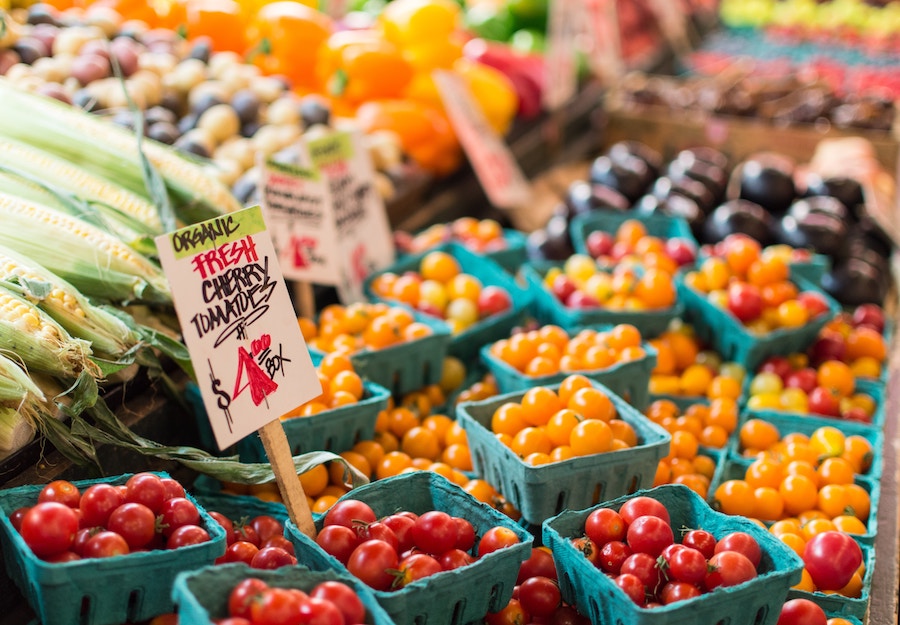
Growing your own food isn’t the only way to get kids more excited about eating better; letting them pick out produce has the same impact. And when you head to a farmer’s market, it’s all about locally grown produce and other homemade goodies, without all of the packaged food distractions of a big supermarket.
Turn the expedition into an active learning opportunity: Encourage kids to use all of their senses to look at, touch, smell, and even taste their way through the super fresh fruits and veggies.
If you have time, I highly recommend your kids start a conversation with a farmer. Challenge them to think of one question to ask, like “how long does it take to grow a tomato?” or “what time did you have to get up this morning to get here?”
I guarantee that your kids will forge a more personal connection with the food you buy — and hopefully a willingness to try something new — when they’ve actually met the people who grew it.
5. Bring on the science experiments.
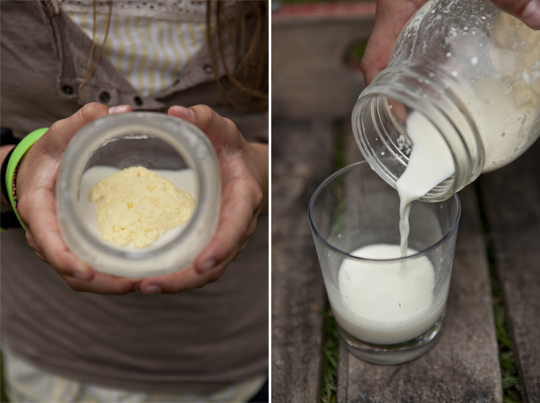
Making DIY butter with kids | Food for My Family
If you love to cook or bake, you know that it’s all about science. And science means experiments!
Even if your kids aren’t particularly into cooking, you can pull them into the kitchen to do some “tests” — and maybe even make a mess.
(I mean, what kid can resist permission to make messes?)
Keep it simple with little ones when it comes to kitchen science. Start with something like the edible play dough project that we found while rounding up fun kitchen projects. Or have them explore color by making rainbow pasta.
With older kids, you can get more serious like Shaina from Food for My Family; she actually started food science camp days with her kids! Check out her instructions for how to make your own homemade butter, which is a great place to start.
The food science fair projects on education.com also offer a ton of inspiration, whether kids are interested in comparing organic vs non-organic produce, or testing different ways to cool your mouth after eating spicy foods.
Just remember: The goal of any of these tips and ideas isn’t to create an immediate willingness for a kid to start loving sprouts. Rather, it’s about making the entire premise of healthy foods interesting and engaging. And that will pay off in the long run.
Thank you to our sponsor the Whole Kids Foundation for creating the Starting with Soil app to help make teaching about healthy eating easier for us and more engaging for our kids. To learn more, find them on Twitter, Facebook, and Instagram.
Top photo by Kelly Sikkema, books photo by Annie Spratt, farmer’s market photo Anne Preble on Unsplash

